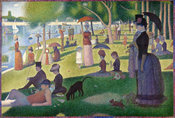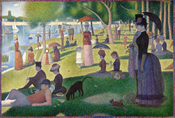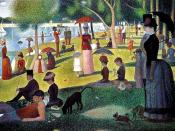Much like the tiny dots of color that make up one of Georges Seurat's stunning successes, there are too, the influences of a variety of past masters inspiring these works that when viewed from further back, create a complete picture. Issues of impending modernity, industrialization and the segmentation of social class between worker and upper class inundated Seurat's Parisian world of the late nineteenth century. Freed from the financial constraints of a working class artist, in his canvasses Seurat thoroughly explored these issues in his unprecedented and unique painting style. Through a groundbreaking scientific use of color, carefully organized composition and an innovative brushstroke technique, Seurat's works incorporate the ideologies of the past in his exciting, highly original works of art.
In "A Sunday Afternoon on La Grande Jatte", Seurat evokes the ideals of several different past movements. At the first glance of the bright dance of light filtering through trees and bouncing off water, this scene seems to belong to the impressionist movement.
Although with its use of bright color to illuminate the relaxation of the warm day's leisure time there remains something amiss; mechanical division of the composition and the stiff positions of the figures seem to mirror those of classicism's strict rules. Adhering to Viruvius's golden ratio, the figures are lined up, forming patterns in the repetition of female figure, parasol and profiles of hats. In this processional order individuals are transformed into anonymous figures, making a statement of the loss of individualism found among those adhering to the strict social requirements of the upper class. It is through his coolly classical representation of what should be a scene of impressionisms' warm leisure of the bourgeoisie, he creates a "critical Realist picture of the artifice and alienation of modern class society." (Eisenman276)
Again in "Young...


